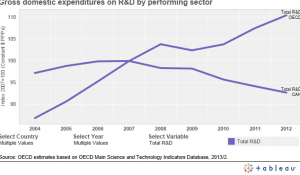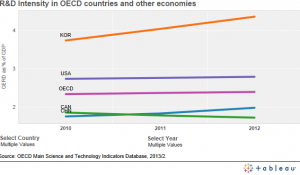Late last month my colleague Dan Herman, writing here on the DEEP Blog, pointed out some concerning trends in Canada’s aggregate government spending on science and technology. The Organization for Economic Cooperation and Development (OECD) has just released new data which further illustrate this trend, and suggest that the problem is not limited to government spending.
While the OECD countries as a whole continue to increase their gross expenditures on research and development (GERD), Canada is moving in the opposite direction.
The graph below shows total R&D spending for the OECD as a whole and for Canada between 2004 and 2012. While the OECD average has been trending upwards fairly consistently, with a slight dip occurring in the years surrounding the 2007-9 Global Financial Crisis, Canada’s total spending continues to move in the opposite direction.

Similar trends are apparent in Canada’s R&D intensity, which measures R&D spending as a proportion of a country’s economic output. As the graph below demonstrates Canada’s R&D intensity, which was already well below the OECD average, continued to trend downwards in 2012. While the OECD as a whole remained relatively flat, other countries, particularly China and Korea, continue to increase the R&D intensity of their economies.

If Canada is going to succeed in the 21st century innovation economy, we need to focus on how to reverse these trends. Recently, former Blackberry CEO Jim Balsillie pointed to Canada’s current intellectual property regime as a barrier to technological innovation, particularly in the resource sector. Here at the DEEP Blog, we’ve also highlighted the need for a new policy framework for innovation. As part of this process, we need to think seriously about both our intellectual property rights regime and the effectiveness of current incentive programs, such as the Scientific Research and Experimental Development Tax Incentive, which are intended to encourage investment in R&D. Incidentally, the DEEP Centre is heading up projects looking at both of those areas. And for good reason, as if we don’t work to both understand and address these trends, Canada risks being left behind in the race to develop the type of high-tech, innovative industries which will power future growth.